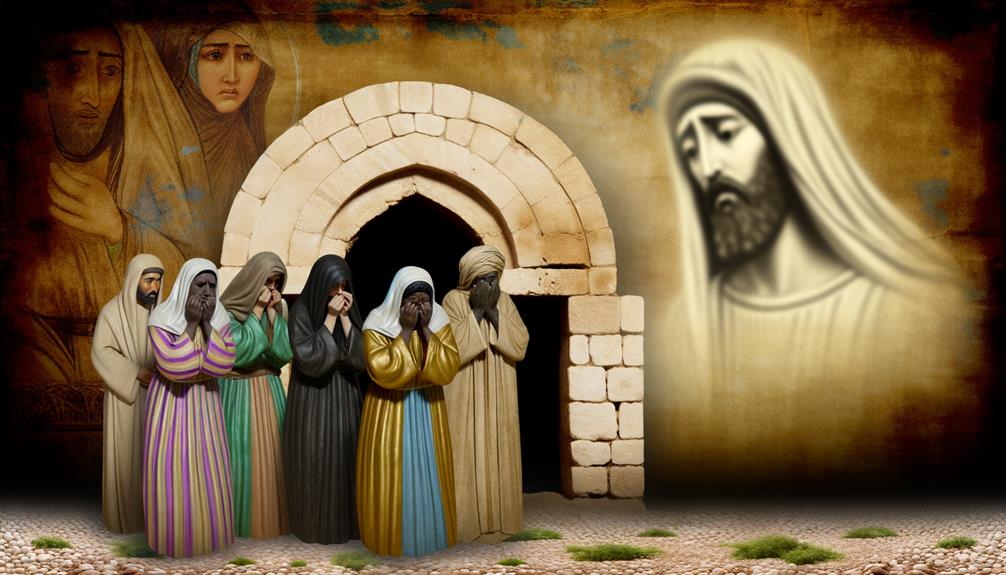Jesus Wept Bible Verse Meaning: Christ’s Compassion
The verse ‘Jesus wept,’ found in John 11:35, epitomizes the profound emotional and theological dimensions of Christ’s nature. Situated within the narrative of Lazarus’s resurrection, Jesus’s tears highlight his deep empathy and solidarity with human suffering, reflecting his genuine humanity alongside his divine identity.
This emotional vulnerability not only underscores his compassionate ministry but also serves as a symbol of divine empathy and comfort. Furthermore, the tears anticipate Jesus’s own conquest over death, enriching Christian eschatological hope.
Exploring this verse further reveals its layered significance, intertwining human grief with divine compassion and redemption.

Jesus Wept: Bible Verse Meaning and Spiritual Significance
| Aspect | Details |
|---|---|
| Phrase Meaning | A powerful expression of Jesus’ deep compassion and sorrow. |
| Biblical Origin | Found in the Gospel of John during the story of Lazarus. |
| Key Bible Verse | John 11:35 – “Jesus wept.” (Shortest verse in the Bible) |
| Common Misconception | Some believe Jesus wept due to lack of faith, but He cried out of love and empathy. |
| Related Bible Verses | Hebrews 4:15 – Jesus understands our weaknesses. Isaiah 53:3 – The suffering servant, acquainted with grief. Psalm 34:18 – The Lord is near to the brokenhearted. |
| Application in Faith | Shows that Jesus understands human sorrow and walks with us in pain. |
| Spiritual Lesson | God is compassionate, caring, and present in our suffering. |
| Encouragement for Believers | In times of grief, trust that Jesus shares in our pain and offers comfort. |
Historical Context

Understanding the historical context of the shortest verse in the Bible, ‘Jesus wept‘ (John 11:35), necessitates an examination of the socio-cultural and religious milieu of first-century Judea.
This period was marked by Roman occupation, which imposed political and social tensions on Jewish society.
Jewish customs and religious practices, deeply rooted in the Old Canon, influenced daily life and communal interactions.
The expectation of a Messiah was prevalent, framed by hopes of liberation and divine intervention.
Jesus’s actions and emotions, including his weeping, must be viewed against this backdrop of Messianic anticipation, religious fervor, and the communal expressions of grief and mourning.
This context elucidates the profound significance of Jesus’s expression of sorrow within its historical setting.
Emotional Depth

The emotional depth of Jesus’s weeping in John 11:35 reveals a profound connection between his divine nature and his empathetic engagement with human suffering.
This brief yet potent verse underscores the complexity of Jesus’s character, emphasizing his ability to deeply feel and express sorrow.
The context of Lazarus’s death highlights not only the personal grief Jesus experienced but also his solidarity with those mourning.
His tears serve as a demonstration of his genuine compassion, bridging the divine and the human experience.
This moment of vulnerability provides a lens through which to understand the multifaceted nature of divine empathy, illustrating that divinity does not preclude emotional engagement but rather enhances the capacity for profound, heartfelt connection.
Jesus’ Humanity

This profound display of empathy not only underscores Jesus’s emotional depth but also serves as a demonstration of his genuine humanity.
The verse, ‘Jesus wept‘ (John 11:35), provides a poignant insight into the dual nature of Christ, emphasizing his incarnation as fully divine and fully human.
His tears at Lazarus’s tomb illustrate a tangible connection to human suffering and mortality, bridging the divine with the ordinary human experience.
This moment of vulnerability reveals an essential aspect of the Christian narrative: a savior who is not detached from human plight but is intimately familiar with its emotional and existential dimensions.
Consequently, Jesus’s humanity is not an abstract theological concept but a lived reality, deeply resonant with human frailty and sorrow.
Compassion and Empathy

Demonstrating profound compassion and empathy, Jesus’s tears at the tomb of Lazarus serve as a powerful tribute to his deep emotional connection with those around him.
This moment, captured succinctly in the verse ‘Jesus wept’ (John 11:35), underscores his ability to share in the sorrows and sufferings of humanity.
Jesus’s empathy is not merely a passive feeling but an active engagement with the grief of Mary, Martha, and the mourners present.
His tears reflect a genuine, heartfelt response to human pain, bridging the divine and the human experience.
This act of weeping situates Jesus as a figure who is not detached from human suffering but deeply immersed in it, offering a model of compassionate leadership and relational depth.
Theological Significance

Understanding the theological significance of ‘Jesus wept’ requires an exploration of its implications for Christology, soteriology, and eschatology within the Christian faith. This moment, recorded in John 11:35, reveals profound truths about the nature and mission of Jesus Christ.
- Christology: It underscores Jesus’ dual nature—both fully divine and fully human—showing His capacity for human emotion.
- Soteriology: It highlights Jesus’ compassion, integral to His role as the Savior who empathizes with human suffering.
- Eschatology: The verse anticipates the future hope of resurrection and the ultimate defeat of death.
This multifaceted significance enriches the Christian theological framework.
Connection to Lazarus

The verse ‘Jesus wept‘ is intimately connected to the narrative of Lazarus, whose death and subsequent resurrection serve as a pivotal event in the Gospel of John.
This brief yet profound expression of Jesus’ sorrow occurs in John 11:35, situated within the larger context of His arrival in Bethany after Lazarus’s death.
The emotional response of Jesus highlights His deep compassion and humanity, providing a stark contrast to His divine authority, later demonstrated by raising Lazarus from the dead.
This act not only underscores Jesus’ power over life and death but also serves to foreshadow His own resurrection.
Consequently, the verse encapsulates a dual revelation of Christ’s empathy and divine mission, enriching the theological narrative of the Gospel.
Jesus and Grief

In the context of Jesus’ display of grief, His weeping over Lazarus’s death provides a profound insight into the interplay between divine empathy and human suffering. This moment reveals several critical aspects of Jesus’ character and mission:
Emotional Vulnerability: Jesus’ tears underscore His genuine human experience, sharing in the sorrow of those He loved.
Empathy: His grief illustrates a deep, personal connection to human pain, reflecting His capacity to suffer alongside humanity.
Divine Compassion: It highlights the compassionate nature of His ministry, emphasizing a God who weeps with His creation.
Foreshadowing Redemption: The act of weeping precedes the miraculous resurrection of Lazarus, hinting at the greater redemption to come.
Thus, Jesus’ grief is both a reflection of His humanity and a prelude to divine intervention.
Symbolism of Tears

The symbolism of tears in the ‘Jesus wept’ verse extends beyond mere sorrow, encapsulating profound layers of emotional expression and theological significance.
These tears reflect Jesus’ deep compassion and his profound human connection to the suffering of others, bridging the divine empathy with human experience.
Emotional Expression of Compassion
Symbolizing profound empathy and heartfelt compassion, Jesus’ tears in John 11:35 reflect a deep emotional connection to human suffering. This brief yet powerful verse encapsulates significant theological and psychological insights:
- Empathy: Jesus’ tears demonstrate an intimate understanding of human pain, transcending mere sympathy.
- Solidarity: By weeping, Jesus aligns himself with humanity’s grief, showcasing divine solidarity.
- Authenticity: His genuine emotional response underscores the authenticity of his compassion, reinforcing his role as a relatable, humane figure.
This verse accordingly serves as a profound representation of the emotional and compassionate depths of Jesus’ ministry.
Human Connection to Suffering
Amidst the narrative of Lazarus’s death, Jesus’ act of weeping serves as a profound symbol, highlighting the intrinsic connection between divine empathy and human suffering. This moment captures the universality of grief and the shared human experience of loss. Tears, in this instance, become a bridge between the divine and mortal domains, underscoring a deeply rooted capacity for compassion.
| Symbol | Meaning |
|---|---|
| Tears | Shared human suffering |
| Jesus weeping | Divine empathy |
| Lazarus’s death | Human mortality |
The act of weeping validates the emotional pain of humanity, suggesting that suffering is not isolated but is deeply felt by the divine. This connection fosters a sense of solidarity and hope in the face of life’s inevitable sorrows.
Divine Empathy and Sorrow
Building on the profound connection between divine empathy and human suffering, the symbolism of Jesus’ tears encapsulates the depth of divine sorrow and its resonance with human grief. This brief yet poignant display of emotion serves multiple profound purposes:
- Embodiment of God’s Compassion: Demonstrates that the divine is not detached but deeply involved in human experiences.
- Universal Human Experience: Connects the divine directly to a fundamental human emotion, making the divine relatable.
- Expression of Genuine Mourning: Reflects sincere sorrow, validating human feelings of loss and despair.
This layered interpretation underscores the theological significance of tears as a symbol of divine empathy and shared sorrow.
Impact on Believers

The profound emotional expression conveyed in the verse ‘Jesus wept‘ resonates deeply with believers, offering a powerful witness to the empathetic and human nature of Christ.
This brief, yet poignant scripture, found in John 11:35, underscores the accessibility of Jesus to human suffering, consequently fostering a sense of intimate connection among followers.
Believers interpret this verse as a validation of their own grief and a reminder that experiencing sorrow is a shared human condition.
Theologically, it emphasizes the incarnation, illustrating that Jesus, though divine, experienced genuine human emotions.
This verse therefore enriches the spiritual lives of the faithful, providing comfort and assurance that Christ’s compassion encompasses their struggles, encouraging them to seek solace in His empathetic presence.
Conclusion
In coinciding historical events and theological exploration, the verse ‘Jesus wept‘ encapsulates profound emotional depth, illustrating Jesus’ humanity and divine compassion.
Through the lens of Lazarus’ resurrection, the symbolism of tears conveys a powerful message about empathy and shared grief.
This intersection of historical, emotional, and theological elements underscores the verse’s enduring impact on believers, offering a multifaceted reflection on sorrow, faith, and the human condition within the Christian narrative.






